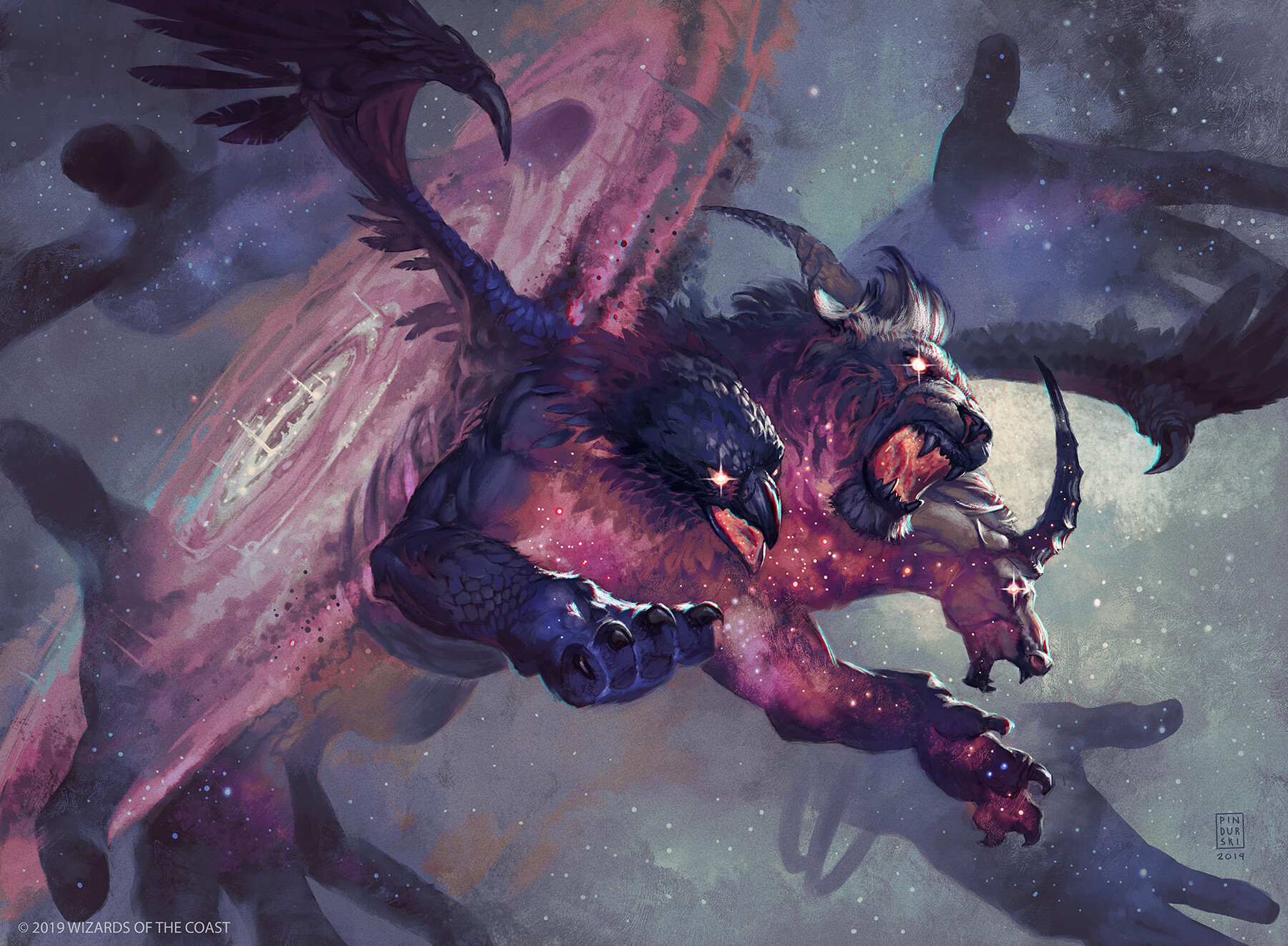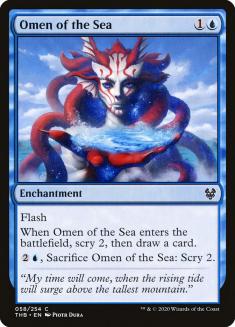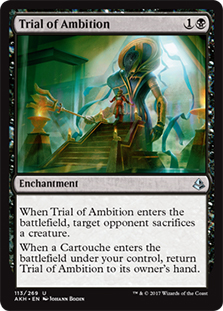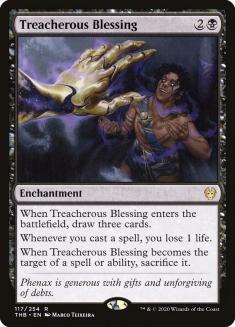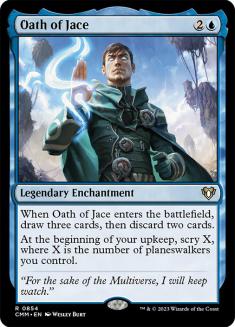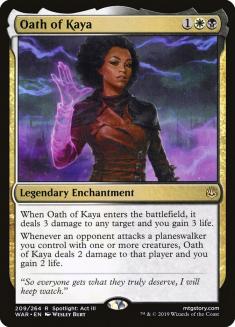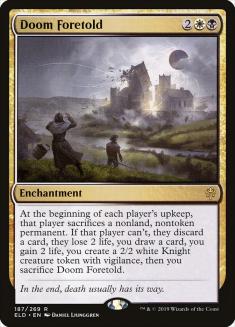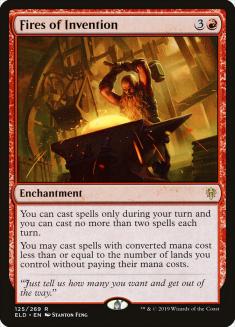Enigmatic Incarnation poses quite the deckbuilding challenge. You need enough enchantments to reliably have them around to sacrifice and enough creatures across the curve to be able to find one you need, and on top of all of that, the biggest challenge, you need a coherent deck. In exchange, you get a Birthing Pod-style effect that doesn’t cost mana to use that many opponents will have a hard time answering.
I suspect this card will want you to have access to at least one additional color to have access to all the tools you’ll want, and I think it has the best chance in Pioneer, where the card pool is deep enough to give you a lot of good options, but at a low enough power level that you can compete.
To start with, you’ll want enchantments that give you value when they enter the battlefield that you don’t care about keeping around, or that you’d actively like to get rid of. The first things that jump out at me are the Omens from Theros Beyond Death, the Oaths, and Treacherous Blessing, but there are plenty of other enchantments that mostly do things when they enter the battlefield, like the Trials.
The next thing to consider is enchantment creatures. Your deck wants you to have a lot of enchantments and a lot of creatures, so enchantment creatures are the easiest way to do this. Eidolon of Blossoms is probably the best of all of them because if you curve a three-cost enchantment into Enigmatic Incarnation, you’ll want to get a four-cost creature, and Eidolon of Blossoms gives you immediate value, has synergy, and allows you to go further up the chain by sacrificing it if that’s what the situation calls for.
Enchantments that cost one aren’t especially desirable because getting a two-cost creature would be relatively low impact. I’m most interested in filling my deck with two- and three-mana enchantments.
By default, I expect to want to build a Sultai deck, largely because Treacherous Blessing and Enigmatic Incarnation play so well together. Assuming that’s the correct direction, in Pioneer, the non-creature enchantments that appeal to me are:
Sagas could also play well here, but no particular one is especially appealing.
At the time of writing, if there are green or black Omens, they haven’t been previewed, but either might be a consideration for this kind of deck. If you’re feeling really ambitious, another enchantment that plays well with Enigmatic Incarnation is Demonic Pact.
Because this deck has a lot of velocity, which is to say, it sees a good number of cards, we don’t need to worry about getting the enchantment count super-high, and really, we want to keep it fairly low so that we have room for creatures and potentially some more interaction, so these are actually plenty of enchantments to work with.
The best enchantment creatures in Sultai historically have been Courser of Kruphix, Eidolon of Blossoms, and to a lesser extent Doomwake Giant. So far, in Theros Beyond Death, I’m interested in Dryad of the Ilysian Grove and Arasta of the Endless Web. These collectively don’t form much of a toolbox, so we’ll certainly want to supplement with some nonenchantment creatures.
Here’s a first pass at what a Pioneer Engimatic Incarnation deck might look like:
Creatures (22)
- 2 Llanowar Elves
- 2 Elvish Mystic
- 2 Courser of Kruphix
- 3 Eidolon of Blossoms
- 1 Doomwake Giant
- 1 Hostage Taker
- 1 Plaguecrafter
- 1 Yarok, the Desecrated
- 1 Cavalier of Thorns
- 3 Gilded Goose
- 1 Arasta of the Endless Web
- 2 Uro, Titan of Nature's Wrath
- 2 Dryad of the Ilysian Grove
Lands (20)
Spells (18)

This deck has four Treacherous Blessings with only Enigmatic Incarnation to get rid of them. That may not be sufficient and the deck might want Vraska, Golgari Queen; Casualties of War; Thrashing Brontodon; or some other card to get rid of it in a pinch.
This deck is also a little light on interaction. I avoided Ravenous Chupacabra to avoid BB casting costs, but casting one wouldn’t be a problem, particularly since you’re hoping to search for it more often than you’ll actually cast it. The land count is a little low for a deck with four cards that allow you to play additional lands, but there’s card draw to balance it out and I think it’s worth playing mana creatures, but you have to keep your total number of mana sources reasonable. I think Uro is too good not to play, but maybe the Dryad isn’t worth it.
When I got to building the sideboard I realized I’d want additional enchantments to bring in when I had to cut Trial of Ambition. I didn’t want to sideboard a card like Nylea’s Presence and I didn’t want to overload on three-cost plays with a lot of copies of Oath of Jace, which lead to maximizing Leyline of the Void. This inspired the consideration that you could build the deck around starting with a Leyline and using Enigmatic Incarnation to turn your leyline into a five-drop when you hit four mana. Good thing Leyline of Abundance is banned in Pioneer because Leyline of Abundance with a mana creature and Enigmatic Incarnation allows you to get a five-cost creature on the battlefield on Turn 2. Is that good enough to build around in Modern?
That probably depends on what we’re getting. My first guess would actually be Cavalier of Thorns, which gets a big boost from the printing of Uro, Titan of Nature’s Wrath. Let’s look at what a Modern Green Devotion deck built around this idea might look like:
Creatures (21)
- 4 Birds of Paradise
- 4 Noble Hierarch
- 4 Burning-Tree Emissary
- 2 Hydroid Krasis
- 1 Fblthp, the Lost
- 3 Cavalier of Thorns
- 3 Uro, Titan of Nature's Wrath
Planeswalkers (2)
Lands (16)
Spells (21)

I don’t think this deck works. That is to say, I think it’s a really bad version of Green Devotion. You just can’t fit enough two- to three-cost enchantments and Enigmatic Incarnation isn’t explosive enough. I don’t think there’s a way to use this card in Modern, but if there is, it doesn’t look like this. It would probably have to be a more interactive deck that uses some kind of engine like Hatching Plans for Renegade Rallier to get card advantage, and while it’d be pretty sweet if a deck based around that were good, I have my doubts based on the current power level of Modern.
However, by exploring it, I think I’ve talked myself around to the idea that Enigmatic Incarnation could actually work in Standard.
Imagine that Uro, Titan of Nature’s Wrath turns out to be one of the best cards in Standard, which I think is quite likely. Imagine further, that even when players aren’t building around Uro, they’re making heavy use of their graveyards, which also seems almost assured. At this point Leyline of the Void becomes an appealing card to maindeck (except when it isn’t). But what if you have Enigmatic Incarnation? Now you can get great value out of that Leyline regardless of how good it was, and even when you plan on sacrificing it, you still likely set your opponent back a few cards in the graveyard by having it on the battlefield for the first few turns, which should slow their escape abilities considerably.
I’d kind of started with the premise that I wasn’t interested in milling myself because it’s generally disruptive to a tutor-based toolbox, but in this case, we can get a lot of synergy if we just accept that we have to build in a bit of redundancy in our toolbox.
So we want to build an Enigmatic Incarnation deck with maindeck Leyline of the Void. We’ll turn that into Cavalier of Thorns, which can find Uro. We’ll want more enchantments. The Binding of the Titans and Tymaret Calls the Dead play well with Uro and play reasonably with Enigmatic Incarnation. We still have Omen of the Sea and Treacherous Blessing. This gives us a solid core to flesh out:
Creatures (15)
- 1 Thrashing Brontodon
- 1 Golgari Findbroker
- 3 Cavalier of Thorns
- 4 Gilded Goose
- 1 Polukranos, Unchained
- 1 Arasta of the Endless Web
- 3 Uro, Titan of Nature's Wrath
- 1 Dryad of the Ilysian Grove
Planeswalkers (2)
Lands (18)
Spells (25)

This deck has enough self-mill to make good use of its escape cards while having access to a toolbox that doesn’t strictly rely on the graveyard and most importantly, gets to capitalize on maindeck Leyline of the Void, which I expect to be a great asset in this coming Standard format.
The next question is whether there’s a reason to look at other colors. Oath of Kaya and Doom Foretold stand out to me because they play well together and Doom Foretold wants you to fill your deck with the same kinds of cards as Enigmatic Incarnation, but playing four colors is a pretty big hurdle.
If we were to look at a Bant build, we could get Calix, Destiny’s Hand as another obvious enchantment synergy card, and The Birth of Meletis plays well with planeswalkers and Enigmatic Incarnation (though you might want to wait until the turn before you plan to cast Enigmatic Incarnation to cast The Birth of Meletis). If we’re talking about Standard, it’s presumably worth mentioning that we’d also get Teferi, Time Raveler. One potential issue is that we have to mind out enchantment count for Calix and play enough creatures to find, which can make it hard to have room for many total planeswalkers. I’m skeptical that there’s anything better here than what Sultai offers.
I’m not sure what you’d want out of red. Fires of Invention is the obvious enchantment, and you do sometimes want to sacrifice it, but you usually want to sacrifice it so that you can spend your mana to cast a third spell in a turn, and if we want to be able to do that after sacrificing Fires of Invention during our end step, we’d need to play instants, which wouldn’t play well with Fires in the first place. It’s cute that you can use Fires to cast Enigmatic Incarnation and immediately sacrifice Fires to get a five-mana creature, but that’s basically the same trick we can already do with Leylines.
My expectations are that Enigmatic Incarnation could potentially be the basis of a competitive Standard deck, mostly because the other cards it wants to play with look pretty good in Standard, and that that deck should very likely be Sultai and make substantial use of escape and play maindeck Leyline of the Void (and maybe other Leylines as well), I think fun but likely not top-tier decks could be built around it in Pioneer, and I don’t think it will be competitive in Modern.

